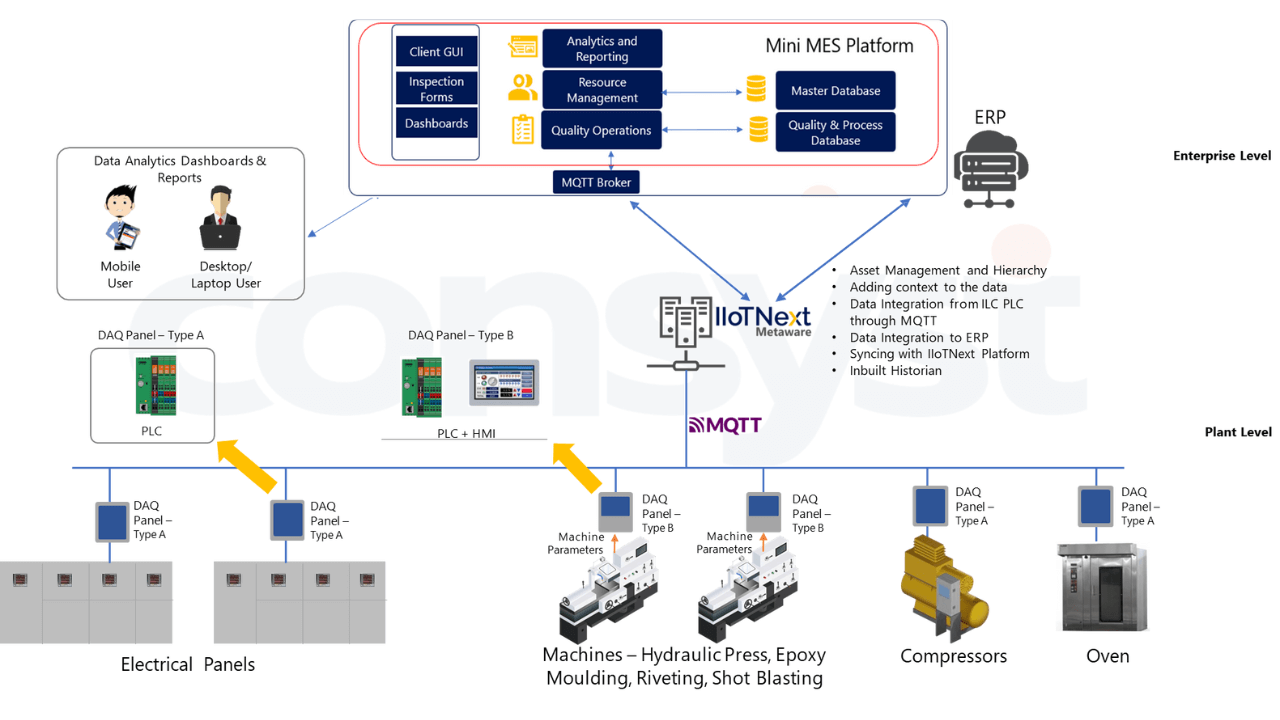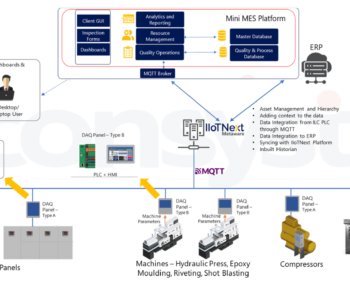Scope:
Consultation, gap analysis, detailed design and engineering, and implementation of IIoT-based Mini MES Solution for implementing OEE, Production/ Downtime, Process KPIs monitoring of moulding, pressing and riveting machines. Additionally, an advanced industrial workflow management was implemented to integrate quality check flow for manufactured products.
Background:
For over 30 years, our esteemed customer has been at the forefront of manufacturing a diverse range of epoxy moulded components, Thermoset, and Thermoplastic products. With multiple plants strategically located across different regions, the client embarked on a visionary journey to establish themselves as an Industry 4.0 Role Model by embracing digitalization and revolutionizing their plant operations.
The plan was to implement an open and scalable IIoT Architecture by employing various digital use cases across the entire organization. The objective was to enable the management to make data-driven decisions and to enhance the quality of the products manufactured.

Our Approach:
To streamline workflow management, quality checks, and visualization, our strategy involved leveraging a mini-MES (Manufacturing Execution System) platform installed on-premises at the client's factory. We deployed dedicated Data Acquisition Panels (DAQ) with an HMI on the field side which is connected to existing machine controller, facilitating data retrieval and acting as operator and quality interfaces. This plug-and-play model significantly reduced engineering efforts, implementation complexity, and on-site work.
To collect data which are not available in existing machine controller we installed a few sensors to measure critical parameters and hooked up with the DAQ panel. By utilizing the existing machine controllers in tandem with the newly added sensors and transducers, we obtained comprehensive and crucial data necessary for analysis and decision-making.
Software Development:
The MES software development and integration process followed an agile development methodology, ensuring efficient and iterative progress. The on-premises deployment comprised of several modules that catered to specific functionalities and contributed to a comprehensive manufacturing execution system which are listed as follows:
1.The Resource Management Module served as a user-friendly interface, providing access to the Master Database for seamless resource management and maintenance. With intuitive navigation and a range of pages, this module could empower users to effectively handle various aspects of resource management.
2.The Quality Operations Module was designed to collect detailed quality information for each part manufactured. This module was made to operate with its own dedicated database, enabling the storage of process parameters and quality-related data. Integration with the HMI allowed for real-time retrieval of process parameters, while a graphical user interface (GUI) facilitated manual entry of quality parameters. Process parameters were automatically captured and transmitted to the Quality Operations Module from the DAQ panel via MQTT when the operator accepts or rejects a part. Additionally, Quality Engineers was allowed the provision to input product dimension information through a form or via connected vernier at quality check stations. The system effectively tracked rejections from four different stations, maintaining separate records for each.
3.The Analytics and Reports Module leveraged the data collected over time to generate comprehensive reports and dashboards. These insights provided valuable information on Overall Equipment Effectiveness, enabling informed decision-making and process optimization.
System Description:
The following solutions were implemented for the moulding, pressing and riveting machines at the facility.
- OEE to give productivity, availability & quality insights.
- Energy Consumption and analysis for each machine
- KPI - Critical to Process (Temperature, Heater Current, Tonnage, Curing Time, Charge weight etc.) and Critical for Quality check.
- Mapping of Critical to Process and Critical to Quality parameters allowing the customer to back track.
- Integration with ERP system.
- Facility to define the quality check workflow at various quality check stations, build various dashboards/reports to enable adequate resource management and analytics.
- Some of the other platform features included:
- The ability to scan and integrate bar codes associated with each product and further account for the approval / rejection of products manufactured.
- Interface for operators to enter product dimensions of manufactured products at various quality stations.
- Provision to input comments by quality team on each product manufactured.
All the DAQ Panels were connected to the plant network via LAN port using Ethernet communication. To enable operator alerting, we provided a 10” HMI on the DAQ panel that enabled Realtime monitoring and sent alerts to the operator, furthermore an audio-visual alarm system was also installed on the DAQ panel to notify the operator of any discrepancies.

The machine data collected were then integrated into IIoTNext Metaware, the flagship middleware software solution offering from CONSYST Digital. The middleware pushed the data to the mini-MES for further Operations and Control. The Platform allowed the customer to access various Dashboards and Reports for Energy Monitoring & Analysis, Production Monitoring, OEE Calculations, Process Parameters Monitoring, Resource Management, Quality Operations & Analytics.
Our solution ensured that management and production heads had secure access to the mini-MES platform, enabling them to view customized dashboards and relevant data based on their respective roles and responsibilities. This role-based access control ensured that individuals in different hierarchical positions could access the information necessary for their decision-making processes.
An intuitive Android App that allowed plant supervisors to conveniently visualize essential information on the go was also provided. This mobile application provided real-time access to relevant data, empowering supervisors to monitor operations and make informed decisions even when they are not physically present on the shop floor.
Result:
- The customer could now access OEE for each machine by getting insights on Productivity, Availability & Quality.
- All critical process parameters and critical quality parameters are monitored and logged, enabling the customer to track the quality of each product manufactured.
- The system logged all the required data associated with each machine, allowing the customer to forecast maintenance schedules and detect unqualified products, analyze the numbers in detail and back trace to the point/cause of defect.
- By seamlessly integrating resource management, quality operations, and advanced analytics the mini-MES Platform drove tangible improvements in quality, productivity, and performance.



